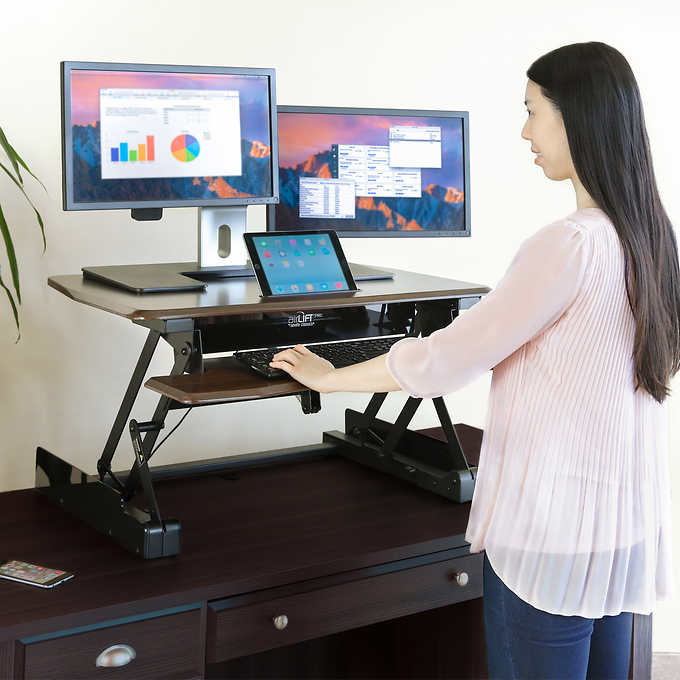This week I was able to reconsider the idea of my final project, a desk with a mechanism to adjust the height, as an initial idea it was very good but I decided to limit it in really fulfilling its function, modify the height of the desk to be able to fight with the pains of back caused by sitting for most of the day, plus you choose to include a mechanism that detects when you are on the desk, in this way to keep track and notify when it is time to get up!
>
What will it do?A desk with adjustable height automatic and / or manual, which detects how long you have been sitting and invites you to get up to avoid low back pain caused by long hours of work in the same position.
>
Who's done what beforehand?When you sit, you use less energy than you do when you stand or move. Research has linked sitting for long periods of time with a number of health concerns. They include obesity and a cluster of conditions — increased blood pressure, high blood sugar, excess body fat around the waist and abnormal cholesterol levels — that make up metabolic syndrome. Too much sitting overall and prolonged periods of sitting also seem to increase the risk of death from cardiovascular disease and cancer.
Any extended sitting — such as at a desk, behind a wheel or in front of a screen — can be harmful. An analysis of 13 studies of sitting time and activity levels found that those who sat for more than eight hours a day with no physical activity had a risk of dying similar to the risks of dying posed by obesity and smoking. However, unlike some other studies, this analysis of data from more than 1 million people found that 60 to 75 minutes of moderately intense physical activity a day countered the effects of too much sitting. Another study found that sitting time contributed little to mortality for people who were most active.
More study is needed on the effects of sitting and physical activity on health. However, it seems clear that less sitting and more moving overall contribute to better health. You might start by simply standing rather than sitting when you have the chance or finding ways to walk while you work. For example:
- Take a break from sitting every 30 minutes.
- Stand while talking on the phone or watching television.
- If you work at a desk, try a standing desk — or improvise with a high table or counter.
- Walk with your colleagues for meetings rather than sitting in a conference room.
- Position your work surface above a treadmill — with a computer screen and keyboard on a stand or a specialized treadmill-ready vertical desk — so that you can be in motion throughout the day.
The impact of movement — even leisurely movement — can be profound. For starters, you'll burn more calories. This might lead to weight loss and increased energy. Also, physical activity helps maintain muscle tone, your ability to move and your mental well-being, especially as you age.
With this in mind, the justification for the project could have great health benefits.
Looking online for some ideas or similar projects, I found some:
Among the mechanisms used for the lifting of the table are motors, gears, linear actuators, among others.
>
What will you design?Design the structure of the desk, which consists of 3 parts, the base legs, the guides that join the legs with the base of the table and the desk table.
The mechanism that will allow the movement of the height of the desk.
The design of the electronics that will lead to the desktop.
>
What materials and components will be used?The desk will be constructed of wood, directly with 15mm plates, which will be assembled to create a design robust enough for the structure.
- 2 linear actuators.
- 1 motor control.
- 1 attiny85 plate (or atmel 328p).
- 1 switch or button on/off.
- 1 gesture detection sensor.
- 1 distance sensor.
- 1 power supply.
- 2 telescopic slides.
- Cables
- Epoxy resin.
- Plywood sheets
>
Where will come from?- http://triplaymarket.mx/
- https://www.mouser.mx/
- http://poliformas.mx/
- https://www.pololu.com/
- https://www.amazon.com/
- http://www.homedepot.com.mx/
>
How much will they cost?| Amount | Product | Cost |
|---|---|---|
| 2 | Linear actuator | $160.00 |
| 1 | Motor control | $5.00 |
| 1 | PCB master | $5.00 |
| 1 | Switch | $1.00 |
| 1 | Sensor APDS-9960 | $14.90 |
| 1 | Distance sensor | $1.80 |
| 1 | Power supply | $18.30 |
| - | Cables | $5.00 |
| 2 | Telescopic slides | $9.90 |
| 5 | Epoxy resin | $83.40 |
| 3 | Plywood sheets | $101.00 |
| TOTAL | $405.30 |
>
What parts and systems will be made?As already mentioned, the construction design of the desk consists of 3 parts, base legs, assembly legs and upper base.
The motor control system for height adjustment.
The gesture control system for height manipulation.
The presence detection system.
>
What processes will be used?- CAD
- Router
- Laser cut
- Electronic design
- Input
- Output
- Molding and casting
- Communications
>
What questions need to be answered?- Will it give you time to do the whole project?
- Can you decrease material or weight?
- How will you put the resin?
- Will you have all the material in time to build?
>
How will it be evaluated?That my final project contains developments and techniques learned throughout this course, besides documenting all the development, involving those details that complicated the project.





